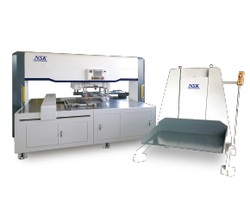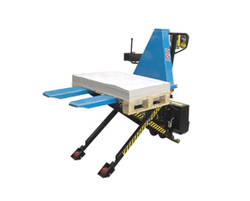MBM Cuts Time for Product Blanking in Half

Habe Taiyodo Co., Ltd.
Mr. Ikuji Habe
President and CEO
Habe Taiyōdō Co., Ltd., since its founding in 1902, has been pursuing technological improvements to its post-print finishing business. With its head office and factory near Gojō station in Kyoto, it is a long-established company which carries out integrated production of all kinds of post-print finishing, such as guillotine cutting, hole-punching, blanking, gluing, folding, foil application, threading (including rubber cord), embossing, and more.

" Offline Blanking, and Pallet Assist enabled us to reduce the labor costs and increase labor."
The multi-blanking machine, commonly known as MBM, is a small-lot production type blanking machine for blanking packages, cards, mounts, labels, as well as pp material. There is a single-head type suitable for blanking single pattern sheets, as well as a twin-head type suitable for blanking layouts with 2 different patterns. In addition to the robust machine body which utilizes 18mm steel for its’ table, the servo control and ball screw drive system enable high-precision blanking even after rigorous usage. By adopting a powerful extrusion pin system that can be fixed simply by inserting pins and a frame that allows easy size adjustments with screw adjustments, MBM can flexibly respond to various blank shapes without the need to create molds or complex adjustments.
"Please tell us why you decided to go with a blanking machine?"

The blanked materials are carried by the automatic
pickup conveyor belt and moved to the pallet by hand.
Mr. Habe: Before we introduced the MBM, all blanking was done manually. A 2 person team was responsible for the manual stripping, but one of the workers had to leave due to hospitalization. This situation forced us to consider adopting a solution involving automation.
Initially, we reviewed machines used by other companies we were familiar with, and several companies became candidates. The machine from Company A was very expensive and required additional software and hardware. Moreover, it was necessary to provide a trap in the print in advance, which was a bottleneck for our company since we perform work on prints received from customers. Additionally, the machine from Company B required the creation of molds for special shapes, and we felt that it did not apply uniform pressure to the shapes, which was a challenge. The machine from Company C required significant preparation time, sometimes taking half a day, and the process of manually transferring materials to pallets after blanking was cumbersome.
Our company’s strength lies in handling the entire process in-house from the die-cut to finished product. We charge customers based on the qty of die-cutting required but the blanking/stripping process is usually included in the price. Decreasing labor costs and time required for this stage of the production was crucial.
MBM utilizes a method with pins where proudcts are individually blanked, eliminating the need for mold creation regardless of the package shape. With a price range less than half of the more complex machines, there is no need for additional software or running costs. The flexibility of simply inserting pins to match the desired shape without the need for molds perfectly matched our company’s needs, so we decided to go with MBM.

to the shape of the blanks.
How do you like the Pallet Assist machine (Automatic Lifting Hand Fork) ?
When materials placed on the hand fork are taken, the sensor responds and adjusts the height accordingly, so there's no need to bend over, reducing the physical demand on the operator. Since lifting and lowering materials is a daily task that requires much physical effort, any assistance to reduce the workload on staff provides significant benefit to efficiency and prevention of injury.
What kind of benefits have you observed after installing MBM?

Lift Hand Fork in operation.
Reduction in labor time. Previously, tasks that took three hours by hand have been cut down to about half. Even regarding prep work (inserting pins/software configuration) for first time jobs, takes no more than 20~30 minutes. MBM is particularly suited for blanking fine shapes. Materials that would tear during manual processing can be quickly and safely punched. After blanking, the packages are automatically picked up and placed on a conveyor belt, which are transported to the operator. By placing a binding machine there, one person can handle the banding and loading onto the final pallet.
Additionally, when the stripping process was done manually, it was necessary to add a cut notch to the material to enable easier removal of the blanks. However, this would cause instances where the material would come apart during the die-cutting process. However, with MBM, there is no need to add this additional cut into the material. This provided benefits not only for the blanking process but also for the die-cut process.
"Please tell us about your company's future initiatives?"

Smart planning such as a bundling machine set
at the unload point ensures delivery preparation with
no wasted time or energy.
Unlike the printing industry, there aren’t dramatic changes in our work process. While there are minor advances in technology that may increase efficiency there are few groundbreaking advances in technology that dramatically change the way we process our products. Nevertheless, we try to focus on new machines or the latest technological trends that offer additional innovation that will give us the competitive edge. We aim to further refine our paper processing techniques and continue to provide these technologies to our customers. Thanks to our efforts, we’ve been able to continue as a company for 100 years, and maintaining this continuity is crucial. Enhancing our technology is essential to achieving this. We hope to remain a company that continues to promote itself with the message, “Leave the post-processing to us” .
Solutions Introduced
MBM
Multi Blanking Machine
For short-run production

More Info A punching machine released as a solution for short-run for extruding packaging, cards, mounts, labels and more. There is no need to create a blanking die, and it can handle a wide variety of product sizes and shapes.
Automatic Lift Hand Fork

More Info A hand fork with an automatic lifting function that anyone can easily operate. The automatic lift brings materials to the height of the work station, allowing a reduction of the burden of manual labor on workers and saving on time allocated to movement. It can easily be introduced as a compliment to existing equipment.
